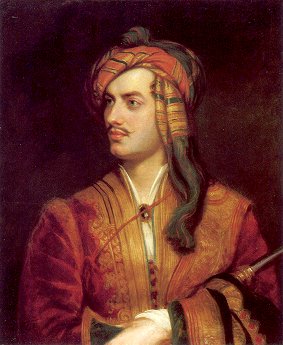To coincide with the publication of Fiona McCarthy’s biography of Byron, this week’s picture is Thomas Phillips’s George Gordon Byron in Albanian Dress. It is a three-quarter-length portrait – a size stipulated by the poet in order to hide his club foot – and it was painted in 1814. The work usually hangs in the British Embassy in Athens but will shortly be put on display in London: one of the prize loans secured for an imminent Byron exhibition at the National Portrait Gallery, it can be seen there from 20 November.
Between 1812 and 1815 Byron enjoyed unprecedented celebrity in the literary and social world of England. The figure of the gloomy, world-weary exile, personified by the hero of his poem Childe Harold’s Pilgrimage, caught the European imagination. Men and women alike wept at public readings of the work. During the same period Byron’s “Oriental” tales of sin and swashbuckling, The Giaour, The Bride of Abydos, The Corsair and Lara were published to enormous acclaim. The poet became confused, in many people’s minds, with his own vivid creations. Cheap illustrations abounded of “Harold”– usually made to look like Byron himself – moodily contemplating a gravestone. Young women who had never met him conceived the fantasy of redeeming his sin-stained soul and the rumour went round that he had actually lived the life of dashing piracy described in The Corsair.
Those who knew Byron remarked that Phillips had failed to catch his likeness, which is hardly surprising given that the restless poet only consented to sit to the painter for half an hour. Despite that, however, the picture succeeds very well on its own terms. It is an aptly poetical portrait, an idealised and somewhat remote image but also one which brilliantly captures Byron’s chameleon-like...


